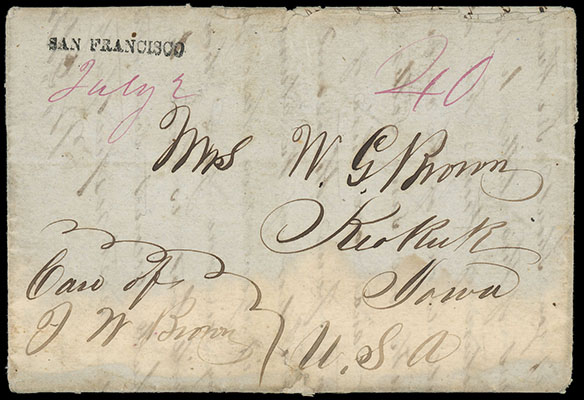

Lot
582 
(Culoma) "Suters Mill, June 13th 1849", datelined on folded miner's letter that entered mails with "San Francisco" straightline postmark with magenta "July 2" dating and "40" rating to Keokuk, Iowa, from miner discussing the high prices, reads in part "…We arrived here this evening at Suters Mill where the gold was first discovered…Everything extraordinary high-for example sas pork one doller per pound-flour the same…There can be a good deal of money to be made by the men that are industrious, the trouble that we anticipated from robbers and ruffians are all a fudge…they have had some trouble with the indians, but it has subsided in a measure and the indians left. We will commence mining probably day after tomorrow. We shall probably go about 12 miles from here on the Middle American Fork where, it is thought, the best diggins are at present…", some staining and faults, Fine. Estimate $1,500 - 2,000.
THE FIRST RECORDED LETTER FROM THE AREA THAT WOULD BECOME COLOMA, THE EARLIEST MINING TOWN.
In the latter part of 1847, John A. Sutter, founder of "New Helvetia", later Sacramento, sent James W. Marshall to find a suitable site for a sawmill. Marshall chose a spot 45 miles Northeast of Sutter's Fort on the South fork of the American River, where Coloma, the earliest of all mining towns in California was founded the following year. Sutter's Mill was finished in March 1848, but on Janaury 24, 1848 Marshall discovered gold in the tailrace. The mill site was a Maidu Indian village named "Ko-Lo-Ma" and became the Miner's Cullomah. The post office began officially Nov. 8th 1849. The post office handstamps were Culloma-Alta California. The name was changed to Coloma Jan. 13th 1851 but the Culloma Post Office cancel continued until 1856. The Indians were forced out of Coloma by Jun 1849. Coloma became the hub of the Northern Mining region and became county seat when the County of El Dorado was created in 1850.
Realized: $2,600
